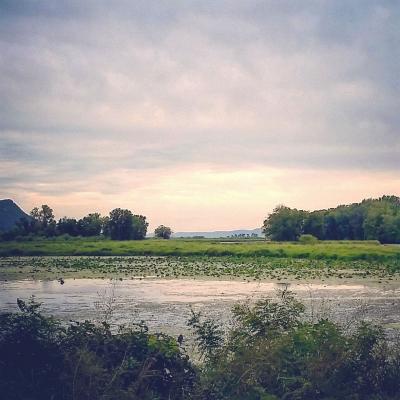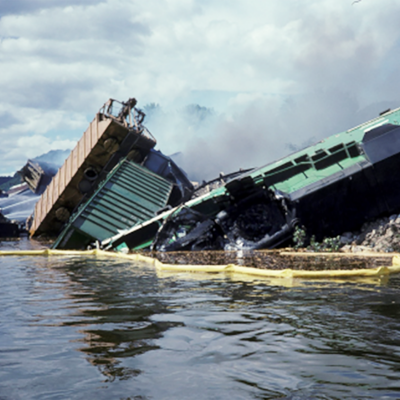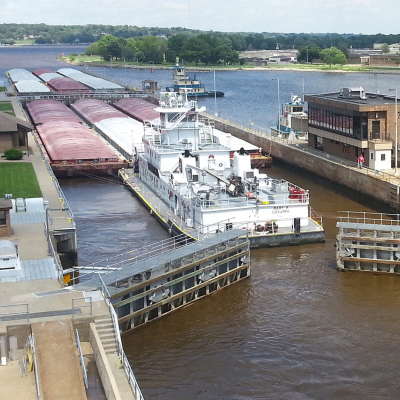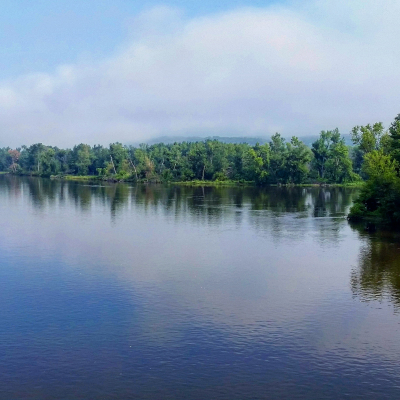The Navigation and Ecosystem Sustainability Program (NESP) is a comprehensive and integrated plan for meeting current and future shipping demands, stimulating economic growth, and improving the health and resilience of the river ecosystem. NESP forges allegiances – allies who gave Congress a solution, a hard-fought consensus. NESP gives us solutions and an extraordinary vision for integrated, multi-purpose management.
NESP will build a second, 1,200-foot navigation chamber at locks 20-25 on the Mississippi River and at La Grange and Peoria locks on the Illinois Waterway that will increase the river’s reliability by adding redundancy with two lock chambers and reduce costs for shippers and consumers by increasing efficiency of lock transit times. Small scale measures (guidewall extensions and mooring cells) will also improve navigation efficiency and safety while minimizing environmental implications. NESP will improve conditions for fish and wildlife through the construction of fish passage, modified dam operations to restore natural river level variability, backwater and island habitat, side channel reconnections, among other projects. Collectively, these restoration activities will helps ensure thousands of species of birds, fish and other wildlife continue to thrive in their natural habitats in and along the Mississippi River. NESP will protect wetlands and lakes from fluctuating water levels and high sedimentation, recreate islands to provide refuge and food for many species of fish and wildlife, and restore natural diversity of water velocities and depths to improve fish habitat. Projects help protect against threats from invasive species, including Asian carp, that outcompete native fish and wildlife for food sources and limited habitat. Still more projects restore forest health and diversity.
NESP enjoys consensus among diverse stakeholders and bipartisan and bicameral support among Congress as well as steadfast commitment by the Governors of the five Upper Mississippi River basin states.
Key Documents and Links
Programmatic
Interagency Consultation
Coordinating Committee (NECC)
UMRBA Statements
Ecosystem Planning (2009-2011 Reach Planning)
Navigation Planning (2010 Lock Sequencing Letter, Capital Investment Strategy and Letters)
Programmatic Arrangements and Planning
Staff Contact
Laura Talbert
History and Authorization
Historic and anticipated increases in shipping on the Upper Mississippi River and Illinois Waterway prompted the Corps to evaluate the merits of investing federal funds to expand the capacity of the river's navigation infrastructure. In 1993, following a favorable reconnaissance-level study, USACE initiated the Navigation Feasibility Study to address and evaluate ongoing problems to navigation, notably the congestion at the busiest locks, growing usage, an aging system.
Consistent with the Principles and Guidelines governing water resources planning, the study employed a 50-year time horizon running through 2050. This proposal for several second lock chambers was viewed as a strong federal commitment to maintain navigation on the river. This spurred a renewed push for addressing the systemic impacts associated with the construction and operation of the 9-foot navigation channel. UMRBA and USFWS underscored that the Navigation Study would set the future course for both commercial navigation and environmental integrity of the river system for years to come. “The resulting infrastructure investments will reaffirm the future of the river as a regulated pooled system. The significance of this decision cannot be overstated.”
Therefore, the states and USFWS put forward that the Feasibility Study comprehensively address not only tow-induced impacts, but the total scope of navigation system impacts, including infrastructure, operation, maintenance, water level, dredging, disposal, and secondary development impacts. UMRBA asserted that the study should “embrace” a more comprehensive set of environmental issues associated with the existence and operation of the navigation infrastructure. Following nearly a decade of considerable controversy and deliberation associated with traffic projections and environmental mitigation, the Chief of Engineers expanded the Feasibility Study’s scope in 2001 to also address ecosystem restoration with a vision “to seek long-term sustainability of the economic uses and ecological integrity of the UMRS.”
The Upper Mississippi River System Navigation Feasibility Study, published in 2004, presented a Recommended Plan to construct a combination of new locks, lock extensions, small scale and nonstructural navigation improvements, and ecosystem restoration measures, with a total estimated cost of $7.7 billion. This includes $2.4 billion for navigation-related measures and $5.3 billion for ecosystem restoration. Consistent with its adaptive implementation approach, the Recommended Plan also identified a First Increment for initial authorization. With a total cost of $3.34 billion, the First Increment Plan included the navigation improvements and associated mitigation identified in 1-4 above ($1.878 billion), as well as the first 15 years of the 50-year restoration plan ($1.462 billion).
Congress enacted the UMRS Navigation Feasibility Study’s First Increment Plan in its 2007 Water Resources Development Act (WRDA) that is known as the Navigation and Ecosystem Sustainability Program (NESP). Congress did not modify the First Increment Plan in any major way, other than updating the funding levels somewhat and including language requiring comparable implementation rates for the navigation and restoration projects. NESP’s authorized funding levels are as follows: $1.948 billion for the seven new locks, $256 million for the mooring cells and switchboats, $1.717 billion for the 15-year ecosystem restoration program, and $10.42 million annually for long term resource monitoring. The ecosystem restoration package includes the construction of multiple fish passages, 65 backwater and island enhancements, 29 side channel reconnections and 92 modifications to channel structures as well as through the modified operations of dams that better mimic natural, seasonal water levels. NESP's authorization is available here.
While the Administration has declined to budget for NESP, USACE did issue implementation guidance for NESP in July 2008. The guidance provided detailed direction for executing the program, addressing questions such as advisory groups and how to ensure comparable progress. The guidance is linked here.




